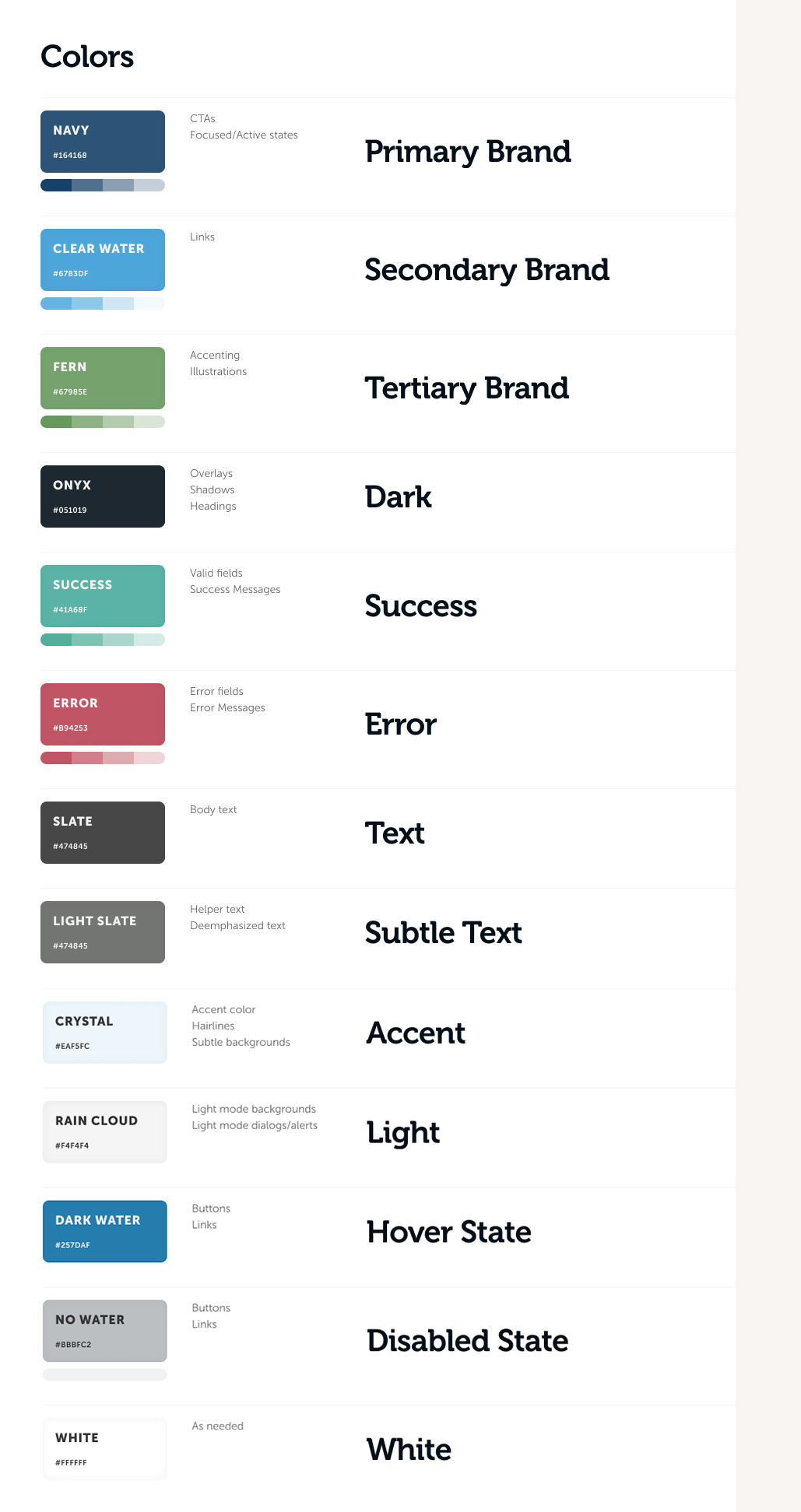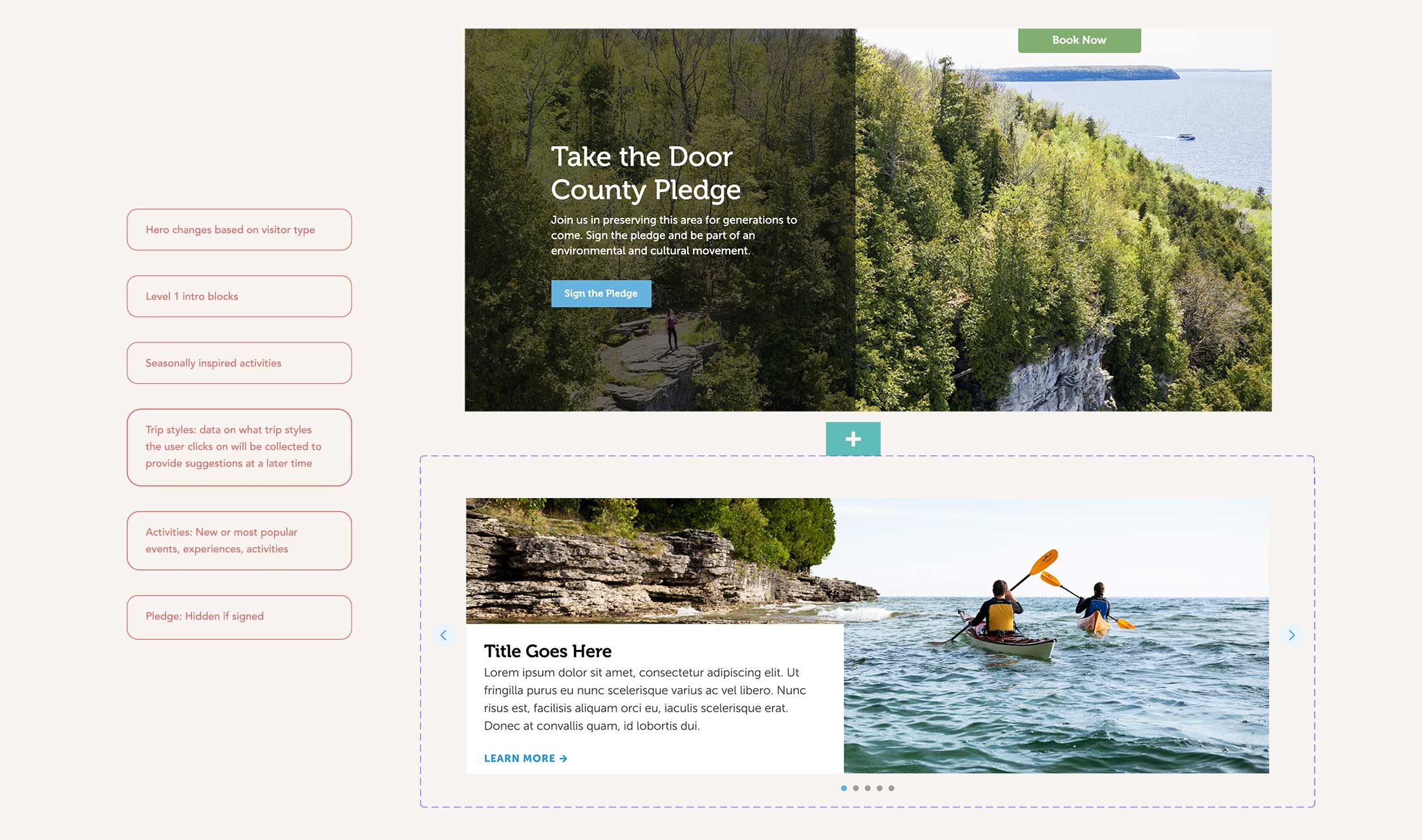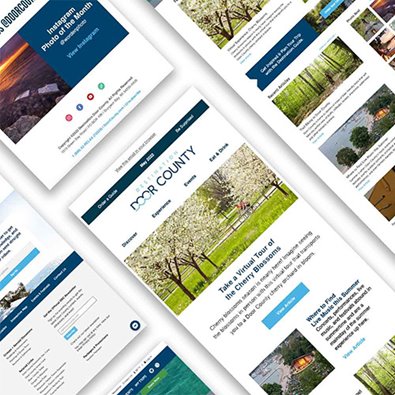Technology plays a vital role for businesses looking to refine and customize their marketing communication strategies. Sophisticated platforms can allow content personalization across a business's website and can even be leveraged within automated email marketing campaigns.
"But one cannot just create custom content," mused agency marketing manager Staci Tischer, "the technology has to be there, and somebody has to literally take the time to set up user and content segmentation."
For Destination Door County, project managers and in-house stakeholders knew that their current website infrastructure was bursting at the seams. For the last year, every new feature built, campaign launched, and bug fixed, were done in a way that would ensure the migration from Umbraco to Kentico Xperience 13 would be as seamless as possible.
To uncover how this migration unfolded, we asked senior client strategist Colleen Campbell, lead project manager Stacy Hannemann, user experience designer Caitlin Mackey, and lead front-end developer Steve Kaufman to share some of the critical elements of this project.

Why was the migration to Kentico Xperience 13 so important?
Colleen: "The answer is twofold. They finally outgrew Umbraco, reaching its database limit which was contributing to site speed, uptime, and security problems. For the size and sophistication of the site, it was better suited to be on a digital experience platform versus just an open-source CMS. They had essentially outgrown the limits of Umbraco."
Stacy: "Exactly; for the last year or so, all involved parties knew that we were creating quick fixes to keep the site's web health at a reasonable level. We saw technical and database issues that could no longer be kept at bay. The CMS would error out. It was so large that it had become unsustainable. Scaling also became an issue during peak travel seasons as spikes in traffic would impact search and directory listings."
Colleen: "It was hard because we always want to help our clients solve problems. In this case, we knew we were delaying the inevitable."
What was the delay?
Stacy: "DDC is arguably one of the largest DMOs in the midwest. Changing platforms always takes time. Even if you're simply lifting and shifting the site from one platform to another, you have to have a project plan and strategy for moving content. Especially this amount of travel and tourism content."
Colleen: "The technology is changing. Web pages need to be rebuilt, and the back-end has to be customized, web tools need to be modified, third-party booking engines have to be reintegrated, databases have to be relinked, and the list goes on."
Stacy: "In this case, we were also future-proofing because we knew what their long-term goals were. We knew they wanted to consolidate assets by leveraging Kentico's integrated email marketing platform. MailChimp is fantastic for many destination marketing or destination management organizations, but keeping data under one roof will help them leverage more sophisticated marketing strategies."
Colleen: "That next step was to rebuild the site using widgets to lay the foundation for content personalization. We took that into account so the audit, strategy, and planning process took nearly six months. It sounds like a long time, but it did make the execution of the migration fast and efficient. We also took this opportunity to incorporate an ADA-compliant design system."

How did the redesign support ADA compliance?
Colleen: "This was not a redesign. It was an evolution."
Caitlin: "Definitely. The UX audit allowed us to do a few things at once. We could evolve the brand to be more ADA compliant, incorporate a component-based design system, and work with our content strategist to display related materials in similar ways. Design-wise, we evolved colors to the proper contrast and cleaned up typography. Ultimately, streamlining the visual experience across different pages, directories, and web tools.

Does the modular system make it easier to personalize content?
Steve: "For the admins? Absolutely. The design system offers extreme flexibility within the system without breaking the user experience. Widgets can be set up with different content across different pages based on user type. These variations create segmented user experiences based on new or returning travelers."
Stacy: "It was a really smooth process. Once Caitlin was done with the design system, and Steve rebuilt each section type in Kentico, we were quickly able to rebuild pages to mirror existing layouts and migrate content."

Was the design system hard to implement?
Steve: "Not at all. Kentico thrives on design systems. The way it's built using widgets and components can be complicated to set up, but it is ultimately more powerful. A dedicated design system actually makes it easier to organize content. Caitlin did such a great job that implementation was super fast and very efficient. It was a great workflow. In the end, almost all of the containers are editable for the client. There are three types of sections and 31 different widgets. Widgets, unlike plug-ins, don't create drag because they're built directly within the system as a drag-and-drop style component."
How did we migrate nearly 7 years of travel and tourism resources?
Colleen: "It was a huge lift — about 736 individual landing pages, blogs, newsletters, and press releases. To manage it, we built a comprehensive content strategy that included site maps, keep, kill, revise lists, and leveraged one of our web tool to track pages by status: whether they needed to be optimized, rewritten, broken apart, or cut entirely."
Stacy: "Thankfully, our content strategist created a project hub for this part of the site migration. She also helped future-proof content by adding vital technical SEO meta-data and alt-tag labels. Everything had to be well organized, detail-oriented, and efficiently executed."
How did this Kentico migration impact website performance?
Colleen: "Out of the gate, it made a significant impact on site speed. It's Core Web Vital scores increased, and web health went up nearly 25% within just a few days of launch."
Stacy: "It was awesome to see."
What's next on the MarComm agenda?
Colleen: "We've been DDC's Digital partner for a long time, and we're so proud of what we've accomplished. The site is now a powerful machine. Now, their in-house team and contributing partners can set up personalized experiences using Kentico's content and marketing apps."
Stacy: "Definitely. Now that the technology and components are in place, they'll be able to use contact groups, personas, and scoring rules to segment users. Then they'll create page variance based on those parameters. It's going to be a sharp user experience."
Website updates can mean many things; updating content, maintaining plugins, monitoring integrations, staying up-to-date with the latest versions of your chosen platform, or lifting and shifting your website to a new platform entirely.
Consider upgrading your CMS and web platform if:
- You're fighting with external link problems
- You're having page visibility issues
- Your site speed is slow
- pages are unresponsive
- You're using old technology in an app or widget?
- We're having trouble updating content
- It has poor analytic results
Sometimes it can be hard to know which issues are growing pains or technical problems. If you're interested in a user experience, development, or technology audit, give us a call to schedule a free consultation.
Technology moves fast and we published this article a while back. To stay current on all things Kentico, subscribe to our digital community or join the Milwaukee Kentico User Group to get the latest platform updates, migration tools and use case advice.



